Chapter: Problem Solving and Python Programming : Algorithmic Problem Solving
Example Programming Algorithm, Pseudocode, Flowchart
ILLUSTRATIVE PROBLEM
1. Guess an integer in a range
Algorithm:
Step1:
Start
Step 2:
Declare hidden, guess
Step 3:
Compute hidden= Choose a random value in a range
Step 4:
Read guess
Step 5:
If guess=hidden, then
Print
Guess is hit
Else
Print
Guess not hit
Print
hidden
Step 6:
Stop
Pseudocode:
BEGIN
COMPUTE
hidden=random value in range
READ
guess
IF
guess=hidden, then
PRINT
Guess is hit
ELSE
PRINT
Guess not hit
PRINT
hidden
END IF-ELSE
END
Flowchart:
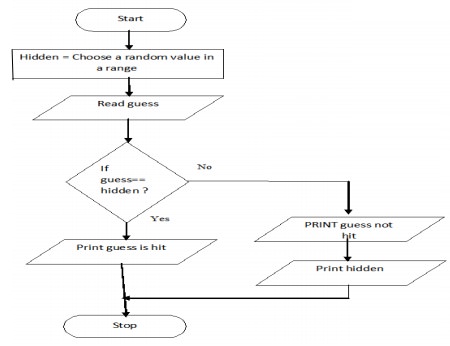
2. Find minimum in a list
Algorithm:
Step 1:
Start
Step 2:
Read n
Step
3:Initialize i=0
Step 4:
If i<n, then goto
step 4.1,
4.2 else goto
step 5
Step4.1: Read a[i]
Step 4.2:
i=i+1 goto step 4
Step 5:
Compute min=a[0]
Step 6:
Initialize i=1
Step 7:
If i<n, then go to step 8 else goto step 10
Step 8:
If a[i]<min, then goto
step
8.1,8.2 else goto 8.2
Step 8.1:
min=a[i]
Step 8.2:
i=i+1 goto 7
Step 9:
Print min
Step 10:
Stop
Pseudocode:
BEGIN
READ n
FOR i=0 to
n, then
READ a[i]
INCREMENT
i
END FOR
COMPUTE
min=a[0]
FOR i=1
to n, then
IF
a[i]<min, then
CALCULATE
min=a[i]
INCREMENT
i
ELSE
INCREMENT
i
END
IF-ELSE
END FOR
PRINT min
END
Flowchart:

3. Insert a card in a list of sorted cards
Algorithm:
Step 1:
Start
Step 2:
Read n
Step
3:Initialize i=0
Step 4:
If i<n, then goto step 4.1, 4.2 else goto step 5
Step4.1:
Read a[i]
Step 4.2:
i=i+1 goto step 4
Step 5:
Read item
Step 6:
Calculate i=n-1
Step 7:
If i>=0 and item<a[i], then go to step 7.1, 7.2 else goto step 8
Step 7.1:
a[i+1]=a[i]
Step 7.2:
i=i-1 goto step 7
Step 8:
Compute a[i+1]=item
Step 9:
Compute n=n+1
Step 10:
If i<n, then goto step 10.1, 10.2 lse
goto st 11
Step10.1:
Print a[i]
Step10.2:
i=i+1 goto step 10
Step 11:
Stop
Pseudocode:
BEGIN
READ n
FOR i=0
to n, then
READ a[i]
INCREMENT
i
END FOR
READ item
FOR i=n-1
to 0 and item<a[i], then
CALCULATE
a[i+1]=a[i]
DECREMENT
i
END FOR
COMPUTE
a[i+1]=a[i]
COMPUTE
n=n+1
FOR i=0
to n, then
PRINT
a[i]
INCREMENT
i
END FOR
END
Flowchart:
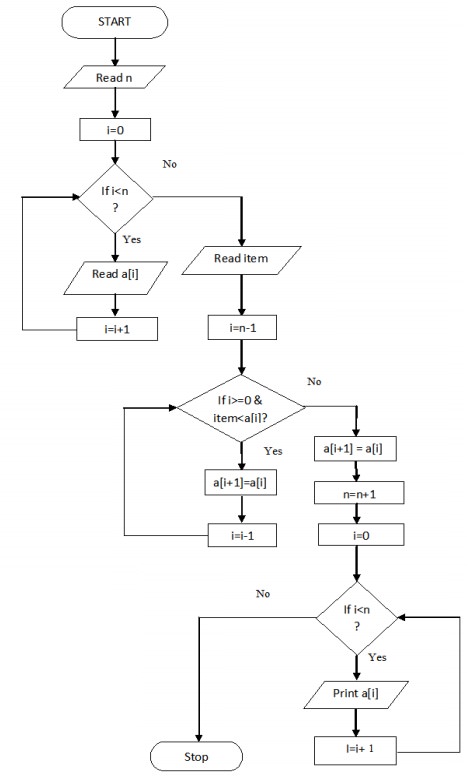
4. Tower of Hanoi
Algorithm:
Step 1:
Start
Step 2:
Read n
Step 3:
Calculate move=pow(2,n)-1
Step 4:
Function call T(n,Beg,Aux,End) recursively until n=0
Step 4.1:
If n=0, then goto
step 5
else goto step
4.2 Step
4.2:
T(n-1,Beg,End,Aux) T(1,Beg,Aux,End) , Move disk from source to desti ation
T(n-1,Aux,Beg,End)
Step 5:
Stop
Pseudcode:
BEGIN
READ n
CALCULATE
move=pow(2,n)-1
FUNCTION
T(n,Beg,Aux,End) Recursiv ly until n=0
PROCEDURE
IF n=0
then,
No disk
to move
Else
T(n-1,Beg,End,Aux)
T(1,Beg,Aux,End),
move isk from source to destination
T(n-1,Aux,Beg,En
)
END
PROCEDURE
END
Flowchart:

Procedure to solve Tower of Hanoi
The goal
of the puzzle is to move all the disks from leftmost peg to rightmost peg.
1.
Move only one disk at a time.
2.
A larger disk may not be p1aced on top of a smaller
disk. For example, consider n=3 disks
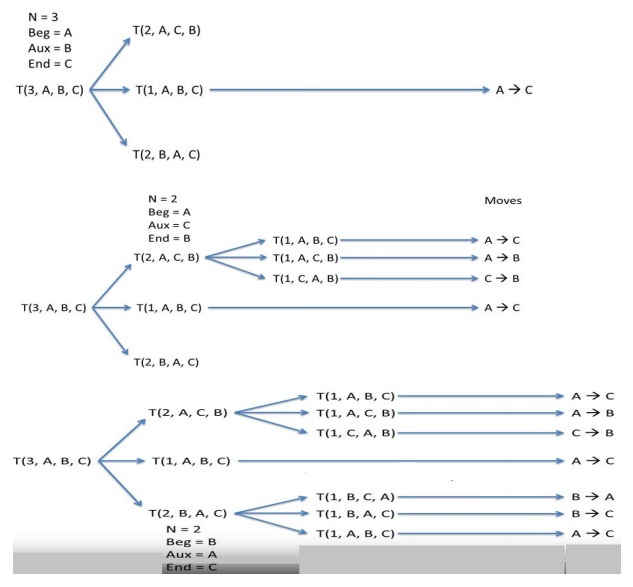
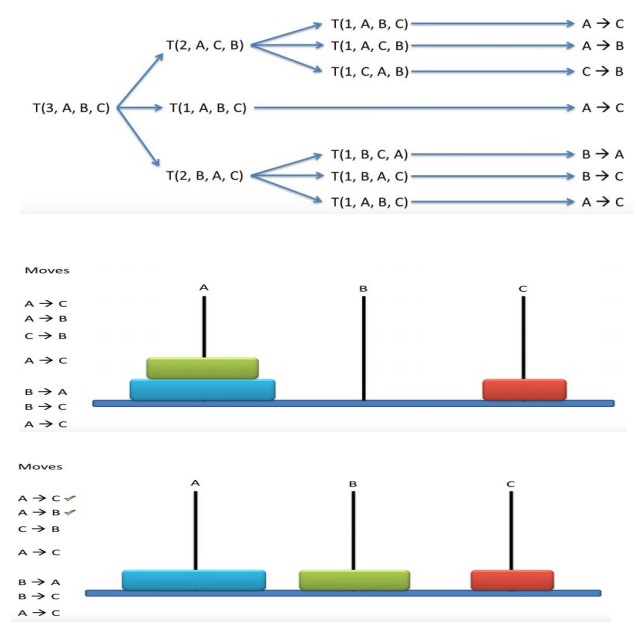
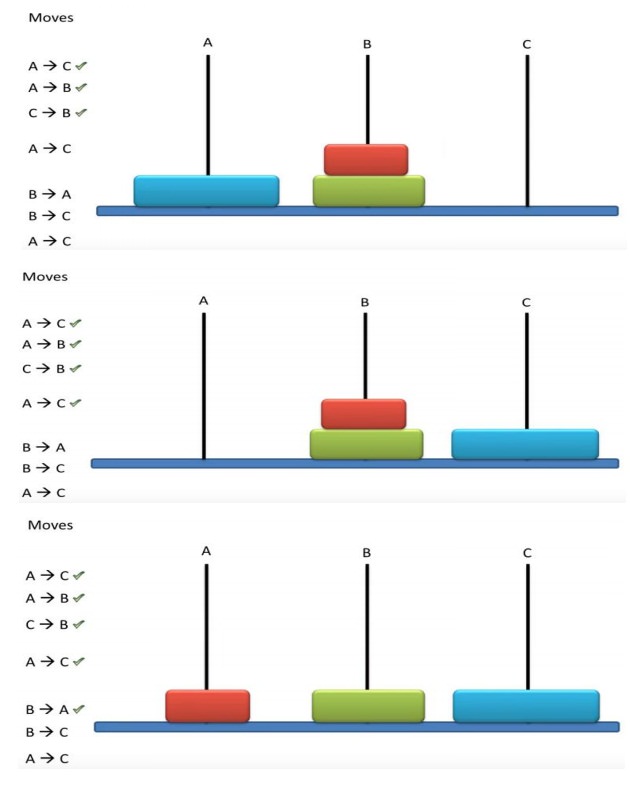
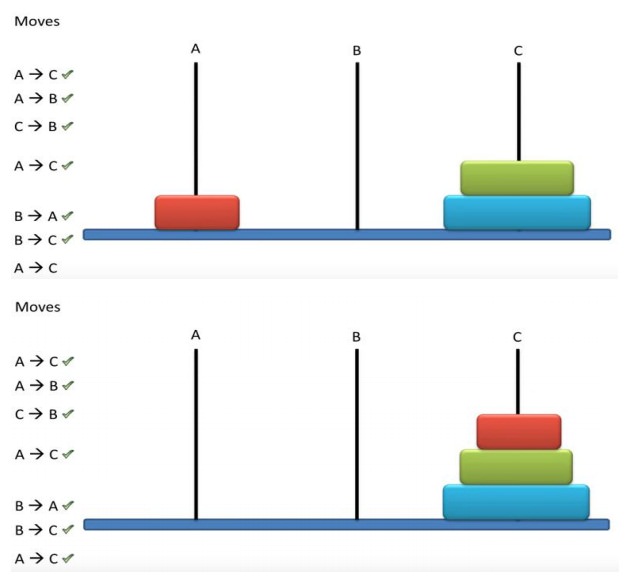
Related Topics